The NVIDIA GeForce GTX Titan X Review
by Ryan Smith on March 17, 2015 3:00 PM ESTPower, Temperature, & Noise
As always, last but not least is our look at power, temperature, and noise. Next to price and performance of course, these are some of the most important aspects of a GPU, due in large part to the impact of noise. All things considered, a loud card is undesirable unless there’s a sufficiently good reason – or sufficiently good performance – to ignore the noise.
The GTX Titan X represents a very interesting intersection for NVIDIA, crossing Maxwell’s unparalleled power efficiency with GTX Titan’s flagship level performance goals and similarly high power allowance. The end result is that this gives us a chance to see how well Maxwell holds up when pushed to the limit; to see how well the architecture holds up in the form of a 601mm2 GPU with a 250W TDP.
| GeForce GTX Titan X Voltages | ||||
| GTX Titan X Boost Voltage | GTX 980 Boost Voltage | GTX Titan X Idle Voltage | ||
| 1.162v | 1.225v | 0.849v | ||
Starting off with voltages, based on our samples we find that NVIDIA has been rather conservative in their voltage allowance, presumably to keep power consumption down. With the highest stock boost bin hitting a voltage of just 1.162v, GTX Titan X operates notably lower on the voltage curve than the GTX 980. This goes hand-in-hand with GTX Titan X’s stock clockspeeds, which are around 100MHz lower than GTX 980.
| GeForce GTX Titan X Average Clockspeeds | |||
| Game | GTX Titan X | GTX 980 | |
| Max Boost Clock | 1215MHz | 1252MHz | |
| Battlefield 4 |
1088MHz
|
1227MHz
|
|
| Crysis 3 |
1113MHz
|
1177MHz
|
|
| Mordor |
1126MHz
|
1164MHz
|
|
| Civilization: BE |
1088MHz
|
1215MHz
|
|
| Dragon Age |
1189MHz
|
1215MHz
|
|
| Talos Principle |
1126MHz
|
1215MHz
|
|
| Far Cry 4 |
1101MHz
|
1164MHz
|
|
| Total War: Attila |
1088MHz
|
1177MHz
|
|
| GRID Autosport |
1151MHz
|
1190MHz
|
|
Speaking of clockspeeds, taking a look at our average clockspeeds for GTX Titan X and GTX 980 showcases just why the 50% larger GM200 GPU only leads to an average performance advantage of 35% for the GTX Titan X. While the max boost bins are both over 1.2GHz, the GTX Titan has to back off far more often to stay within its power and thermal limits. The final clockspeed difference between the two cards depends on the game in question, but we’re looking at a real-world clockspeed deficit of 50-100MHz for GTX Titan X.
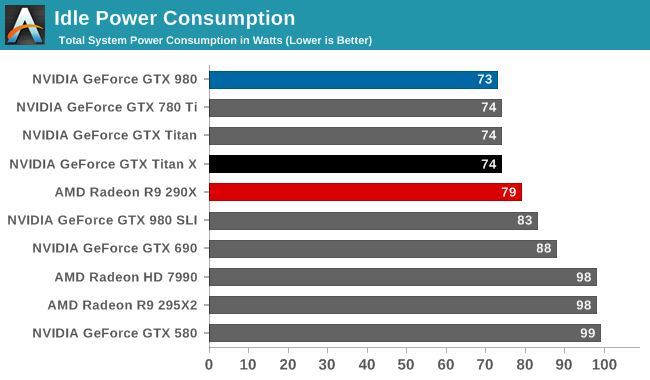
Starting off with idle power consumption, the GTX Titan X comes out strong as expected. Even at 8 billion transistors, NVIDIA is able to keep power consumption at idle very low, with all of our recent single-GPU NVIDIA cards coming in at 73-74W at the wall.
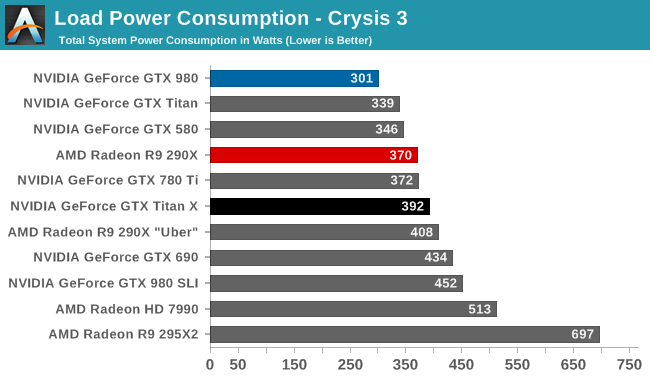
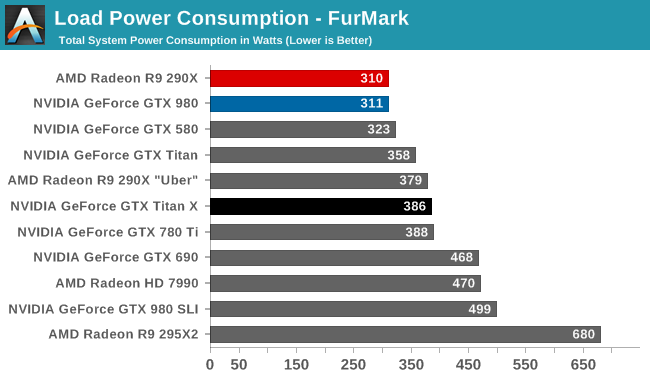
Meanwhile load power consumption for GTX Titan X is more or less exactly what we’d expect. With NVIDIA having nailed down their throttling mechanisms for Kepler and Maxwell, the GTX Titan X has a load power profile almost identical to the GTX 780 Ti, the closest equivalent GK110 card. Under Crysis 3 this manifests itself as a 20W increase in power consumption at the wall – generally attributable to the greater CPU load from GTX Titan X’s better GPU performance – while under FurMark the two cards are within 2W of each other.
Compared to the GTX 980 on the other hand, this is of course a sizable increase in power consumption. With a TDP difference on paper of 85W, the difference at the wall is an almost perfect match. GTX Titan X still offers Maxwell’s overall energy efficiency, delivering greatly superior performance for the power consumption, but this is a 250W card and it shows. Meanwhile the GTX Titan X’s power consumption also ends up being very close to the unrestricted R9 290X Uber, which in light of the Titan’s 44% 4K performance advantage further drives home the point about NVIDIA’s power efficiency lead at this time.
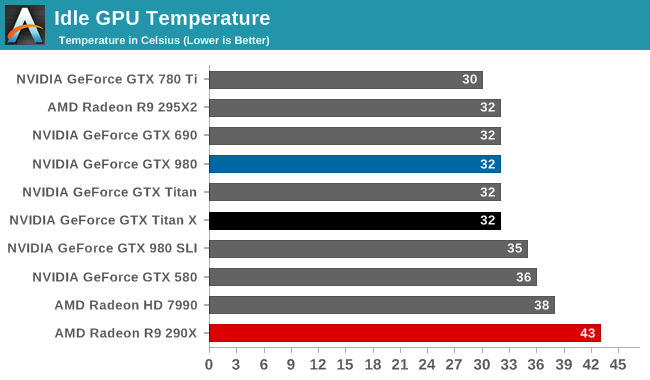
With the same Titan cooler and same idle power consumption, it should come as no surprise that the GTX Titan X offers the same idle temperatures as its GK110 predecessors: a relatively cool 32C.
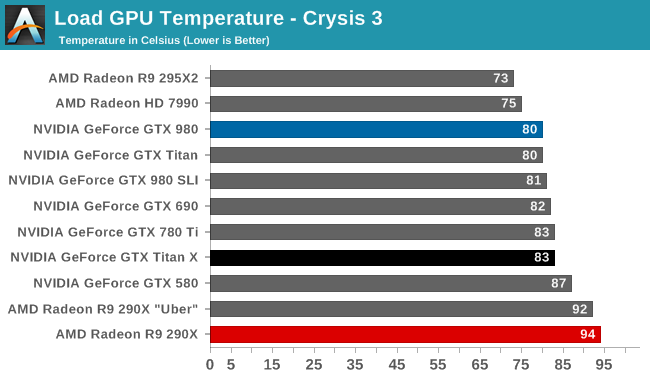

Moving on to load temperatures, the GTX Titan X has a stock temperature limit of 83C, just like the GTX 780 Ti. Consequently this is exactly where we see the card top out at under both FurMark and Crysis 3. 83C does lead to the card temperature throttling in most cases, though as we’ve seen in our look at average clockspeeds it’s generally not a big drop.

Last but not least we have our noise results. With the Titan cooler backing it, the GTX Titan X has no problem keeping quiet at idle. At 37.0db(A) it's technically the quietest card among our entire collection of high-end cards, and from a practical perspective is close to silent.
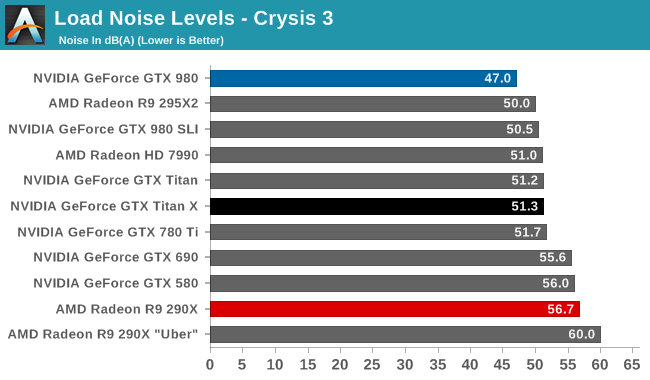
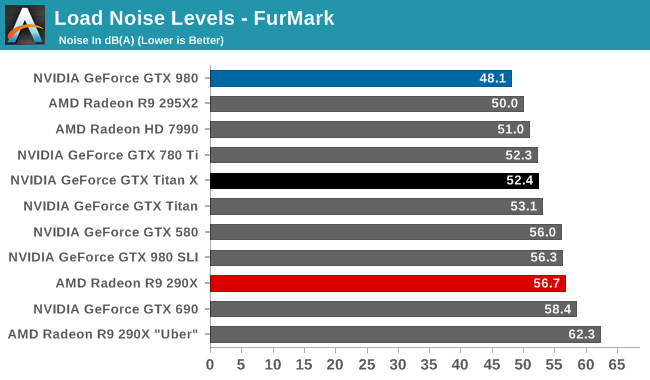
Much like GTX Titan X’s power profile, GTX Titan X’s noise profile almost perfectly mirrors the GTX 780 Ti. With the card hitting 51.3dB(A) under Crysis 3 and 52.4dB(A) under FurMark, it is respectively only 0.4dB and 0.1dB off from the GTX 780 Ti. From a practical perspective what this means is that the GTX Titan X isn’t quite the hushed card that was the GTX 980 – nor with a 250W TDP would we expect it to be – but for its chart-topping gaming performance it delivers some very impressive acoustics. The Titan cooler continues to serve NVIDIA well, allowing them to dissipate 250W in a blower without making a lot of noise in the process.
Overall then, from a power/temp/noise perspective the GTX Titan X is every bit as impressive as the original GTX Titan and its GTX 780 Ti sibling. Thanks to the Maxwell architecture and Titan cooler, NVIDIA has been able to deliver a 50% increase in gaming performance over the GTX 780 Ti without an increase in power consumption or noise, leading to NVIDIA once again delivering a flagship video card that can top the performance charts without unnecessarily sacrificing power consumption or noise.










276 Comments
View All Comments
Jdubo - Thursday, March 19, 2015 - link
290x was the original Titan killer. Not only did it kill the original release but killed its over-inflated price as well. I suspect the next reiteration of AMD flagship card will be Titan X killer as well. History usually repeats itself over and over again.jay401 - Thursday, March 19, 2015 - link
You say this is not the same type of pro-sumer card as the previous Titan yet the price is the same. No thanks.Ballist1x - Thursday, March 19, 2015 - link
No gtx970/970 sli in the review;) Anand you let the consumers down...H3ld3r - Thursday, March 19, 2015 - link
R9 290x only haves 4Gb at 5ghz and does a awsome job at 4k. the 295 only operates with 4Gb the other 4 are mirrored and shines in 4k. So i can't understand everybody concerns with 4k gaming with upcoming fiji. This Titan X has 12GB at 7Ghz and only shows how gddr5 is obsolete.oranos - Friday, March 20, 2015 - link
The ratio of potential buyers to comments on this article is atronomical.leignheart - Friday, March 20, 2015 - link
Hello everyone, I would like you to read the final words on the Titan X. It says the performance increase over a single gtx 980 is 33%, except the price is 100% over the gtx 980. If you are lucky enough to pay just 1000$ for the Titan X. Please people do not waste your money on this card. If you do then Nvidia will keep releasing Extremely overpriced cards. DO NOT BUY THIS CARD.Please instead wait for the gtx 980 TI if you want dx12. I will certainly pay 1 grand and more for a card, but this card is a particular rip off at that price point. Don't just throw your money away. Read the performance chart yourself, it is in no way shape or form worth 1000$.
Dug - Monday, March 30, 2015 - link
I suppose we can't buy a Rolex, Tesla, a vacation condo, or even a pony?Paying for the best available is always more money. Get a job where another $500 doesn't affect you when you purchase something. Plus price is only perception on worth. People could say $20 is too much for a video card and they would be right.
themac79 - Friday, March 20, 2015 - link
I wish they would have thrown in 780sli, which is what I run. I would like to have more VRAM, but I'm running all the new games pretty much maxed out. I made the mistake of buying them when they first came out and payed over $600 a piece. I will definitely wait for price drops this time.H3ld3r - Friday, March 20, 2015 - link
You need is more transistors, memory speed, stream processors, bus, rops, tmu's not memory amountArchetype - Friday, March 20, 2015 - link
4K gaming not quite there yet. Not going to pay $500+ for it. And in the mean time still jamming Full HD games like a baws using my old 280X "on my Full HD monitor".